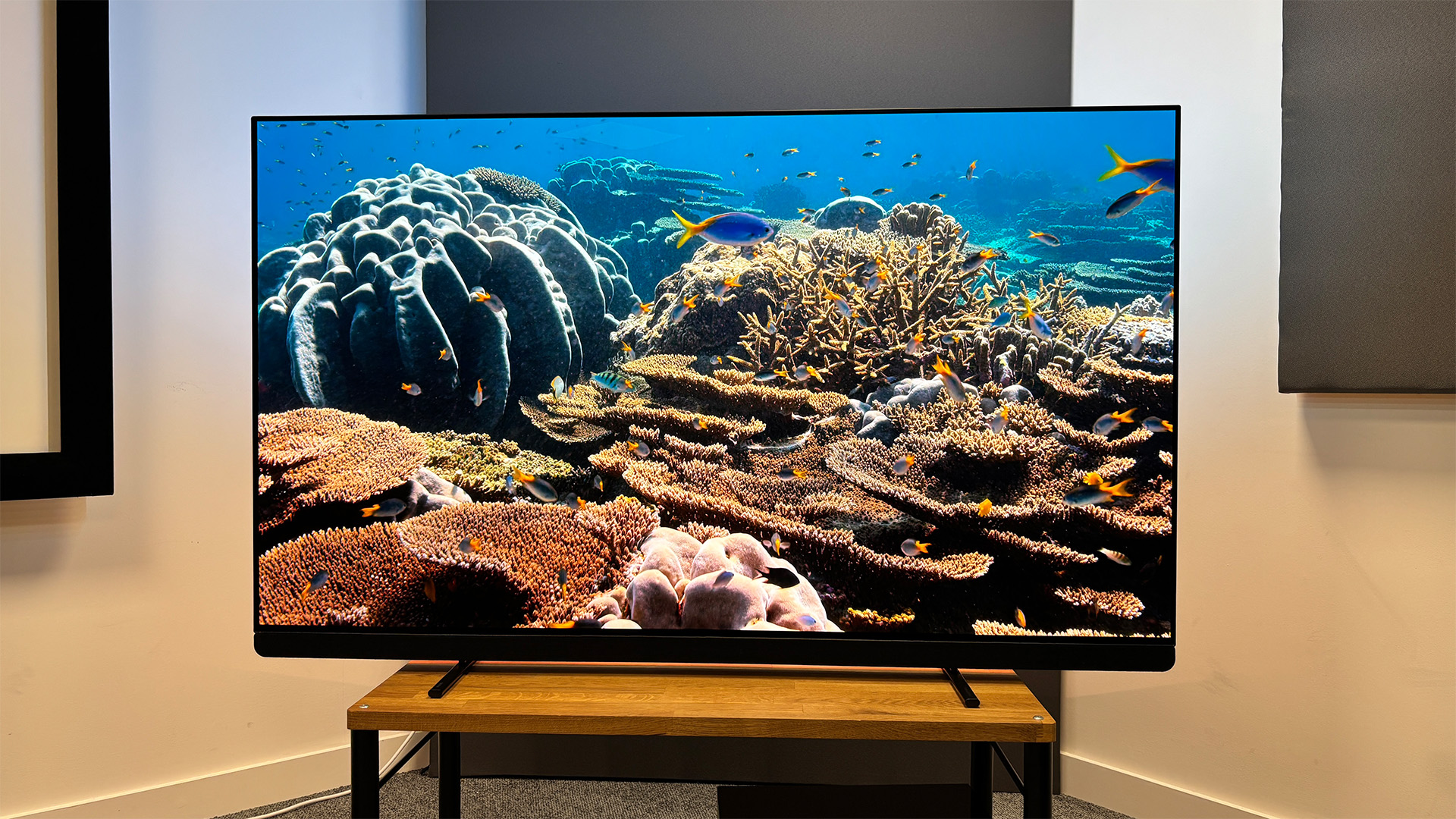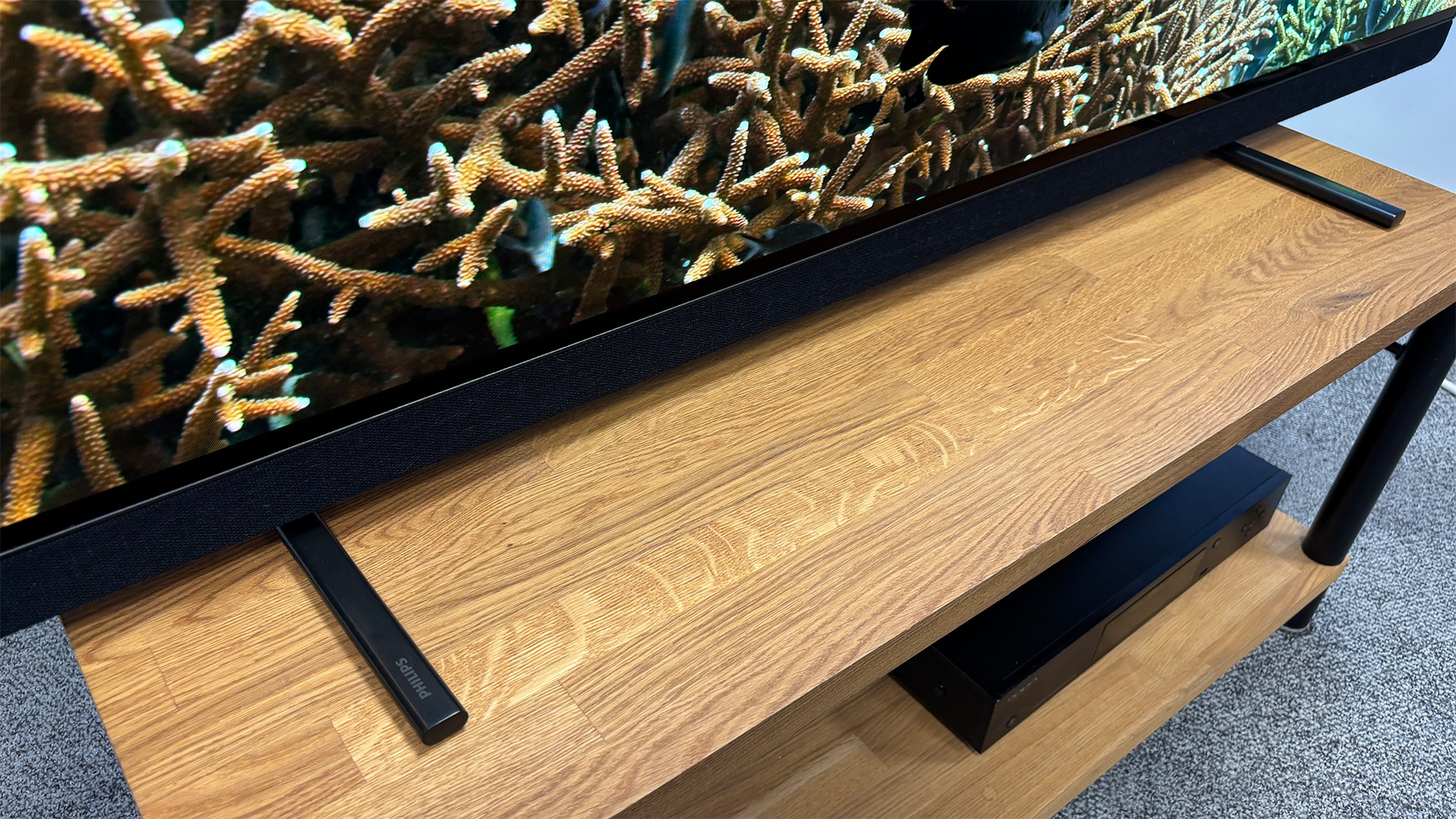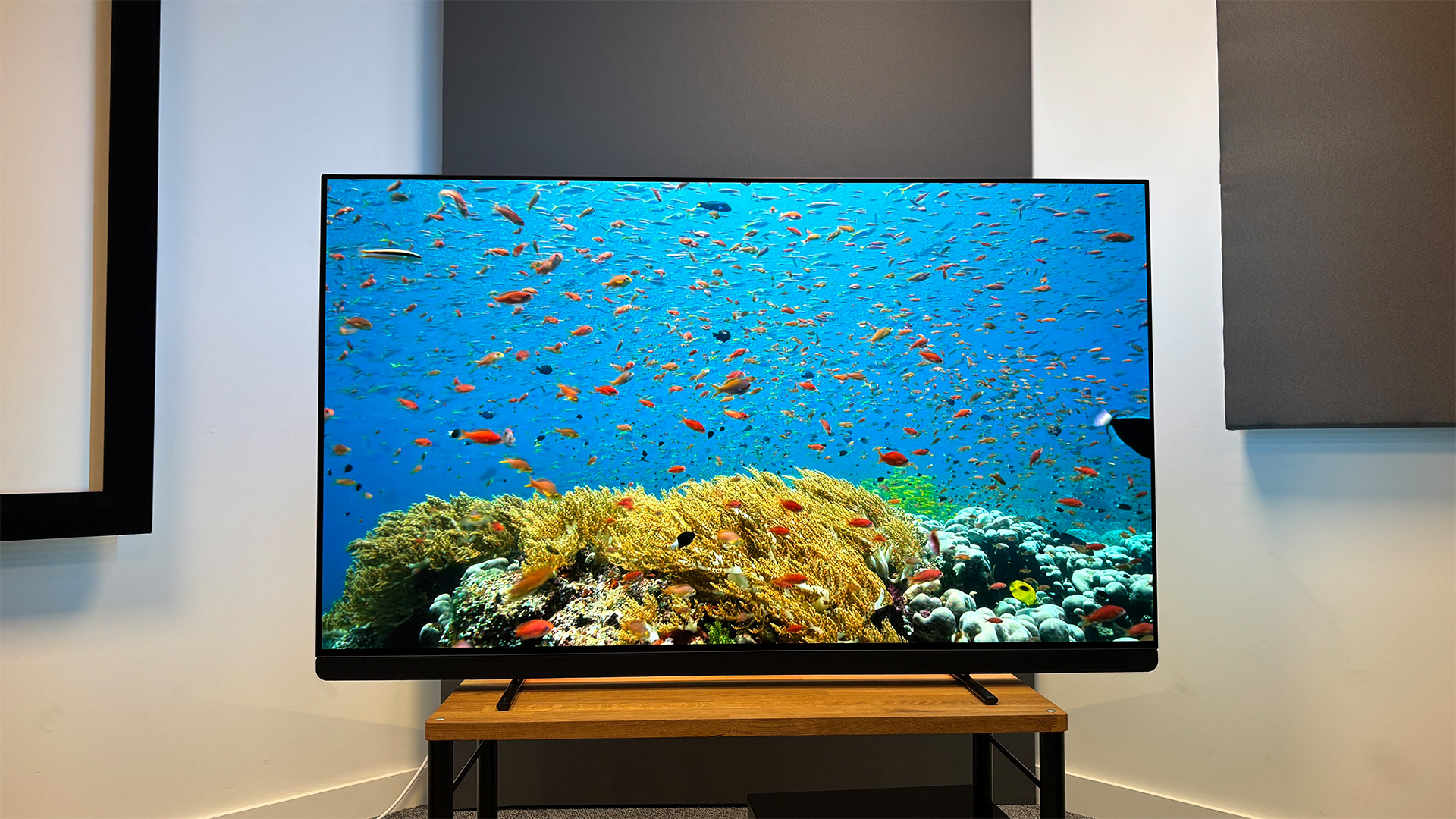What Hi-Fi? Verdict
There is so much to like about this Philips TV, but unfortunately it's too close to its step-down model and beaten for picture performance by its competitors
Pros
- +
Bright and detailed picture
- +
Impressive audio by TV standards
- +
Four sided Ambilight is dazzling
Cons
- -
Picture is too similar to the step-down model
- -
Incredibly tough competition
- -
Still beaten for sound by a soundbar
Why you can trust What Hi-Fi?
Philips’ OLED TVs have stood toe to toe with the likes of Sony, LG and Samsung for many years now, which is no small feat considering that Philips is a smaller brand compared with these global conglomerates. The company has kept up with advancements in panel technology despite having reduced influence outside of Europe, and it continues to leverage its exclusive Ambilight technology and ongoing partnership with legendary British hi-fi brand Bowers & Wilkins to create TVs with unique appeal.
The OLED909 embodies this statement as it includes all of the features mentioned above. Technically speaking, it's not even Philips’ flagship model in this range – that title is given to the OLED959 which is a further step up from this model. That being said, the OLED909 is what we’d consider to be the “mainstream flagship” as the 959 is positioned as an even more premium proposition.
So where does that leave the OLED909? It’s beneath the top model and contending with a cheaper five-star model, which is a tricky place to be. Ultimately, this means that the OLED909 can’t help but be overshadowed by its little brother, the OLED809.
Price

First and foremost, we’ll have to let our American and Australian readers down gently here and say that this TV isn’t available outside of Europe. This is to be expected though, as Philips has never (to our knowledge) launched one of its OLED TVs in either of those regions, so prospective buyers in the US and Australia will need to look elsewhere. It’s also worth noting that if you want this TV, it’s currently only available at Richer Sounds here in the UK.
Philips launched this 65-inch model at £3499 initially, which was in line with competitors from LG and Samsung. However, the price has since dropped to around £2799; and while that is mostly good news, the LG G4 (which is also an MLA OLED TV) and Samsung S95D QD-OLED have dropped even lower to around £2700 and £2600 respectively. This puts the Philips at a slight disadvantage price-wise, but it’s not enough of a gap to recommend another model on cost alone, and those models have notably weak sound systems and no unique feature akin to Ambilight. You can also currently find the 55-inch model for £1999 or the 77-inch variant for £4499.
Stepping away from the next-generation OLED technology and back into the realm of “WOLED” (traditional OLED TVs), the OLED909 (much like many other step-up models on the market) becomes a harder sell. The five-star step-down model in Philips’ lineup, the OLED809, is currently down to £1899, while other five-star alternatives like the LG C4 (£2099) and Sony Bravia 8 (£1945) prove that you can get top notch performance from OLED without brightness boosting tech (and at a much cheaper price).
Build

Philips tends to build the more eye-catching OLED TVs on the market, if we’re talking purely about design. The OLED909 is no exception, though this year’s model trades function for form in one aspect. Philips has opted to include two pill-style feet on the OLED909 and, while it looks suave, it means that the swivel functionality seen on the OLED907 and OLED908 is no more. It’s not the end of the world but losing the ability to twist the TV to access the HDMI sockets or point the TV to another seating position is a shame nonetheless.
The latest hi-fi, home cinema and tech news, reviews, buying advice and deals, direct to your inbox.

Screen size 65-inches (55- and 77-inches)
Type OLED
Backlight N/A
Resolution 4K
HDR formats HLG, HDR10, HDR10+, Dolby Vision
Operating system Google TV
HDMI inputs x 4 (2 x 48Gbps HDMI 2.1)
Gaming features 4K/144Hz, VRR, ALLM, Dolby Vision gaming
ARC/eARC eARC
Optical output? Yes
Dimensions (hwd, without stand) 74 x 123 x 5.6cm
Thankfully, Philips has restored a feature in return for losing the swivel stand. Four sided Ambilight makes a grand return on this top-end model, with embedded LEDs adorning the top, sides and bottom of the back panel. Recent models, for reference, lacked the bottom row of lights, which is nice to have if you’re wall-mounting the TV. We’ll dig more into how Ambilight works in the features section, but the bottom line is that, while it’s still divisive amongst the What Hi-Fi? AV team, it's a unique feature that, when used right, is brilliantly clever.
Elsewhere, this TV is definitely one of the more stylish models on the market, with its super-slim side profile and soundbar covered in a tasteful black Kvadrat fabric material along the bottom edge. The borders around the screen are also razor thin, which gives the TV a sleek and modern look when powered on.
The OLED909 also comes with Philips’ sturdy metal remote, which features iPhone 14-like flat sides and a weighty, premium feel in the hand. It gets bonus points for being backlit too, and the button selection is a solid balance of being functional without being overbearing. There is even a USB-C socket (and cable in the box) to recharge the remote; a trend we’re pleased to see is making its way to more TVs every year.
Features

As was the case with last year’s OLED908, the OLED909 is outfitted with a META OLED panel courtesy of LG Display. It features the second generation brightness boosting technology that we’ve also seen on the LG G4, with peak brightness figures quoted in the region of 3000 nits. This is a pretty significant step up from the non-MLA touting Philips OLED809, which peaks at a claimed 1300 nits.
One aspect in which Philips fends off its competitors is HDR support. The OLED909 supports all of the major formats, including HDR10, HDR10+, Dolby Vision and HLG. Other brands tend to choose either Dolby Vision (LG, Sony) or HDR10+ (Samsung), but Philips takes an agnostic approach to HDR formats, meaning you won’t have to pick one or the other.
Philips’ P5 AI chipset is also inside this TV, and it powers a plethora of picture features grouped into what Philips refers to as the P5 Perfect Picture Engine. This encompasses a wide range of confidently named “perfect” picture processing functions, including Perfect Natural Motion and Micro Dimming Perfect. Furthermore, the P5 AI engine drives the AI PQ mode which can adapt the picture setting based on the content you’re viewing; for example, it can boost saturation and motion for sports, or tone those settings down for a more authentic film-watching experience.
Moving on to connectivity, the Philips offers up the expected (yet still frustrating) combination of two HDMI 2.1 and two HDMI 2.0 sockets – a combo we’ve come to expect from manufacturers that rely on MediaTek’s Pentonic 1000 chipset. The HDMI 2.1 connections offer the latest gaming specifications, including 4K/120Hz gaming with VRR and ALLM, which should be plenty for console gamers, though PC gamers might favour the 144Hz support found on new Samsung and LG OLEDs.
If you prefer to access content directly from the TV, then you can utilise the built-in Google TV smart system. As is the case with the previous generation of Philips TVs, there are a couple of notable absences when it comes to regional catchup services – namely BBC iPlayer and Channel 4. ITVX and Channel 5 both make the cut, however, and global streaming apps such as Netflix, Disney Plus, Apple TV and Amazon Prime Video are all present and correct. You can plug an external media streamer into this TV to get around the missing apps, but that will incur additional cost and a degree of hassle that shouldn’t be necessary.

Of course, two features specific to this model make it stand out against the competition: the aforementioned four-sided Ambilight and the built-in Bowers & Wilkins sound system. We’ll start with Ambilight.
While it might not be to everyone’s taste, we can’t help but smile when the golden sands of Dune: Part Two’s desert or the neon lights of Blade Runner 2049’s dystopian city are projected onto the wall of our testing room. While we recommend scaling back the ferocity of the Ambilight system (and it can be turned off if you’re dead-set against ambient light infiltrating your room), there is something to be said for how it aids immersion. Enhancing the system to include the bottom row also allows for more convincing effects that take place on the lower portion of the screen too, which makes it even more engaging.
Moving onto the sound system, the OLED909 packs a 3.1 channel 81W arrangement developed by Bowers & Wilkins. The system comprises a front-firing speaker bar arrangement on the lower portion of the frame and a subwoofer in the middle of the rear panel. It supports a range of audio formats too, including Dolby Atmos and DTS:X.
Picture

It seems as though everyone is on their A-game for 2024, with LG, Samsung, Sony and Philips all delivering some stellar TVs where picture is concerned. This means that the OLED909 has to fend off competition and stand out from the crowd in order to achieve five stars from us. And, while this TV does deliver a picture with a long list of positive attributes, there is a sense of familiarity that we can’t entirely get past.
We have the OLED909 set up side-by-side with its more affordable counterpart, the OLED809. We also have the (sadly discontinued) Oppo UDP 203 hooked up to both models and our usual 4K reference discs (Oppenheimer, Top Gun: Maverick, Pan, Mad Max: Fury Road), non-4K reference material, and Netflix to test how this TV performs with a variety of material. We also find that Filmmaker Mode (Filmmaker Dolby Vision for the appropriate content) provides the most accurate picture out of the various modes available, though we do experiment with the Pure Cinema motion feature and Highlight Enhancer setting too. The higher brightness on this set might be more at home on the OLED909’s punchier Vivid Mode and toned-down (but still enthusiastic) Home Cinema mode, but as is the case with all of our TV reviews, we prioritise picture accuracy.
Overall, the Philips OLED909 gets a lot right. Oppenheimer plays into the strengths of this model, as its crisp image ensures everything from skin to clothing and environmental textures is detailed. In true Philips fashion, there does seem to be an emphasis placed on ensuring colours are bold and bright, which can look right at home on vibrant content such as Mad Max. The golden sands of the post-apocalyptic desert practically glow orange, which contrasts pleasingly with the teal sky. Skin tones lean slightly warmer as a result, though Filmmaker mode does its best to wrangle them under control to ensure they don’t verge on overcooked.

Contrast is also a strength, with this TV delivering a strong sense of three-dimensional depth, and while it doesn’t quite rival the Sony Bravia 8 and A95L in this regard, it’s still an adept performer nonetheless. Broadly speaking, motion is also well handled on this TV, providing you knock down the setting to either off, or Pure Cinema. There is a bit of evident stutter as Maverick hits Mach 10 during an overhead shot in Top Gun: Maverick; however, that is because we’ve opted to turn the motion settings down in favour of a more natural presentation overall. Pure Cinema is a decent option for smoothing out noticeable stuttering, as long as you don’t mind a touch of motion processing.
There is one inescapable issue though, and that is that, in most cases, the OLED909 looks incredibly similar to the OLED809 – albeit with brighter highlights. Watching the war rigs tear through the desert in Fury Road, we find that the OLED909 has a touch more detail and the glints of sun reflecting off the chrome mirrors and the bursts of flames erupting from exhausts (and a certain guitar) certainly draw the eye more, but they otherwise look incredibly similar.
The one film where we didn’t find this to be the case is with Pan, which is notably mastered to 4000 nits. The TV laps up the higher brightness and wields it to great effect compared with its cheaper counterpart, aided by the MLA technology in delivering a stunningly bright image. We use the sequence in which the flying pirate ship enters a mystical land with floating bubbles of water and observe many instances in which the OLED909 bests the OLED809.
For instance, the sun is notably brighter and more impactful, and the clouds within its immediate vicinity retain more detail thanks to the additional peak brightness headroom, which in turn limits clipping around that area of localised high brightness. The image itself is brighter overall, but looking into glimmers of light hitting the waves or ripples in the middle of the floating bubbles is where we see bigger picture quality improvements, even if these are subtle elements overall.
While the OLED909 shines for brighter content like Pan, it’s worth noting that content such as this is few and far between. For a vast majority of content mastered towards lower brightnesses, the OLED909 delivers a less noticeable upgrade when in its more accurate picture mode. Its flashier picture modes will pump up the brightness for a more obvious difference, but in doing so you sacrifice picture authenticity – so it’s not something we’d recommend doing. Ultimately, for watching the majority of films and TV shows in the settings we’d recommend, the OLED909 only delivers a slight upgrade over the cheaper OLED809.
Sound

Philips touts the sound system in this TV as a key selling point, but has B&W’s influence solved the issue of middling TV audio? The answer is mostly yes, as the OLED909’s audio is a cut above that of many OLED TVs we’ve tested this year, but it’s not perfect.
Using the intro of Top Gun: Maverick in Dolby Atmos, we find that the built-in speakers deliver a clear and punchy sound with surprisingly solid dynamics. The roar of jet engines crackles with excitement and an underlying rumble of bass adds an extra layer of immersion. The sound is crisp and clear, and while it can verge on sounding a bit lean at times, it’s wholly impressive by TV standards.
Speaking of bass, Blade Runner 2049’s tricky chapter 2 score utilises the rear-mounted subwoofer to deliver pulsating low-end effects with ample depth. While a separate subwoofer as part of a surround-sound package will undoubtedly deliver more convincing ground-shaking bass, the Philips once again proves to be an admirable performer amongst its peers.
It also handles Dolby Atmos spatial effects well, with a spacious and open sound that makes a decent attempt at tracking the jet planes as they zip across the runway of the aircraft carriers. It’s not as directional as an external sound system, but we can hear the B&W speakers attempt to shift the sound around in a fairly organic fashion in order to replicate a sense of space.
Furthermore, the speaker arrangement is about as musical as TV sound systems come, which shouldn’t be a surprise considering Bowers & Wilkins’ hi-fi pedigree. Kenny Loggins’ iconic Danger Zone track bursts into life on the OLED909, with impressive vocal clarity and snappy timing, making it a darn sight more engaging than your typical OLED TV’s built-in speaker system.
The issue remains that you would still be better served by a decent quality Dolby Atmos soundbar such as a Sonos Arc or Sennheiser Ambeo Plus. This, in turn, puts you in a tricky spot of bypassing the audio system which contributes to the higher price of this TV. If you have absolutely no intention of purchasing a soundbar or speaker package, then this could very well be the TV for you – but if you do have an external sound system, then the B&W arrangement becomes an expensive addition that will be of no use to you.
Verdict

In many ways, the Philips OLED909 is ever so close to greatness. It’s bright, detailed and sounds good by TV standards. However, its competitors – the LG G4 and Samsung S95D – undercut it where price is concerned, they don’t have the issue of missing apps, and they have better gaming features too.
Of course, those rivals lack Ambilight, and they can’t hold a candle to the OLED909’s excellent sound system. That being said, the OLED809 is very close where picture quality is concerned, and it can be paired with a Dolby Atmos soundbar for a better sonic experience too.
SCORES
- Picture 4
- Sound 5
- Features 4
MORE:
Read our review of the Samsung S95D
Also consider the LG G4
Read our Sony Bravia 8 review
Best TVs: flagship OLEDs and affordable flatscreens tried and tested
Lewis Empson is a Senior Staff Writer on What Hi-Fi?. He was previously Gaming and Digital editor for Cardiff University's 'Quench Magazine', Lewis graduated in 2021 and has since worked on a selection of lifestyle magazines and regional newspapers. Outside of work, he enjoys gaming, gigs and regular cinema trips.
- Ketan BharadiaTechnical Editor

